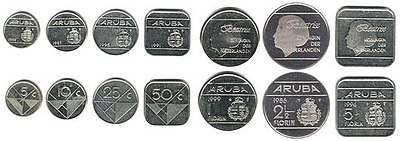Aruban florin
Afl.[1] | |
|---|---|
| ISO 4217 | |
| Code | AWG (numeric: 533) |
| Subunit | 0.01 |
| Unit | |
| Plural | florin |
| Symbol | Aƒ, ƒ[citation needed] |
| Denominations | |
| Subunit | |
| 1⁄100 | cent |
| Plural | |
| cent | cent |
| Banknotes | Afl. 10, Afl. 25, Afl. 50, Afl. 100, Afl. 200 |
| Coins | 5¢, 10¢, 25¢, 50¢, Afl. 1, Afl. 2+1⁄2, Afl. 5 |
| Demographics | |
| Date of introduction | 1986 |
| User(s) | |
| Issuance | |
| Central bank | Central Bank of Aruba |
| Website | cbaruba |
| Printer | Crane Currency |
| Website | cranecurrency |
| Mint | Royal Dutch Mint |
| Website | royaldutchmint |
| Valuation | |
| Inflation | 4.4% (2011)[2] |
| Method | CPI |
| Pegged with | 1 U.S. dollar = Afl. 1.79 |
The florin (Dutch: [floːˈrɪn]; abbreviation: Afl.; code: AWG[1]) or Aruban guilder is the currency of Aruba. It is subdivided into 100 cents. The florin was introduced in 1986, replacing the Netherlands Antillean guilder at par. The Aruba currency exchange rate for U.S. dollars is Afl. 1.77 for cash and Afl. 1.78 for traveller's checks. Most supermarkets and gas stations use the exchange rate of Afl. 1.75, while many restaurants and shops use the exchange rate of Afl. 1.80.[3]
Coins
[edit]In 1986, coins were introduced in denominations of 5, 10, 25 and 50 cents and 1 and 2+1⁄2 florin. Later, the 5-florin banknote was replaced by a square coin and the 2+1⁄2-florin coin was removed from circulation. The 5-florin was replaced in 2005 with a round gold-coloured coin, because the old square 5-florin coin was too easy to counterfeit. All coins are struck in nickel-bonded steel with exception of the 5-florin, which is an alloy of copper and other metals. The 50 cent is the only square-shaped coin remaining, also commonly referred to as a "yotin" by the locals.[citation needed]
On the back of each 1-, 2+1⁄2- and 5-florin coin is a profile view of the current head of state of the Kingdom of the Netherlands. From 1986 to 2013, this was Queen Beatrix and since 2014 it has been King Willem-Alexander. Moreover, only these three denominations have writing on their edge, namely God zij met ons, meaning 'God be with us'.[citation needed]
Banknotes
[edit]The Central Bank of Aruba (Centrale Bank van Aruba) introduced banknotes in denominations of 5, 10, 25, 50 and 100 florin and dated 1 January 1986.[4] In 1990, the bank issued the same denominations in a colourful new family of notes designed by Aruban artist Evelino Fingal. As director of the Archaeological Museum, Fingal found inspiration in old Indian paintings and pot shards. Fingal combined decorative motifs found on pre-Columbian pottery with pictures of animals unique to the island. The 500-florin notes were introduced in 1993, with the 5-florin note replaced by a square coin in 1995.
As of 2003, a new print was started of the then already existing banknotes of 10, 25, 50, 100 and 500 florin. These new banknotes were made with new safety features to counteract counterfeiting, but retained their look.[5][6]
In 2019, the Centrale Bank van Aruba unveiled a new series of banknotes in denominations of 10, 25, 50, 100 and 200 florin, with the latter serving as a new denomination. The theme presented for this series is "Life in Aruba", as it contains elements of Aruban flora, fauna, cultural heritage, monuments and landmarks. They were issued on 4 June 2019, and is circulating alongside the 2003 series until 11 August, after which the 2003 series of banknotes were no longer legal tender. Commercial banks in Aruba accepted the 2003 series of banknotes until December 4, afterward the notes will be redeemed at the Central Bank of Aruba for up to 30 years, until 11 August 2049. The 100 Florin note was awarded "2019 Banknote of the Year" by The International Banknote Society for its content, art, and security features.[7]
|
| ||||||||||||||||||||||||||||||||||||||||||||||||||||||||||||||||||||||||||||||||||||
| Banknotes of the Aruban florin (2019 issue) | ||||||
|---|---|---|---|---|---|---|
| Image | Value | Main colour | Description | Date of issue | ||
| Obverse | Reverse | Obverse | Reverse | |||

|
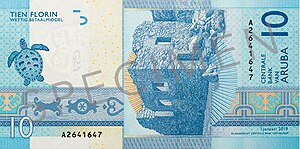
|
Afl. 10 | Blue | Green sea turtle | Bushiribana gold mill ruins | 1 January 2019 |

|
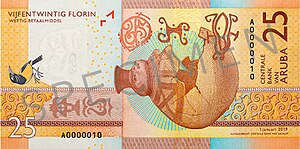
|
Afl. 25 | Orange | Venezuelan troupial | Arawak pottery and cave paintings | |

|

|
Afl. 50 | Red/purple | Red land crab | Willem III Tower, Fort Zoutman (Oranjestad) | |
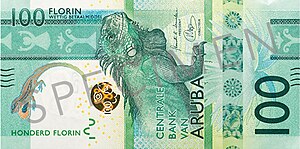
|

|
Afl. 100 | Green | Green iguana | Baile di Cinta dancers | |

|
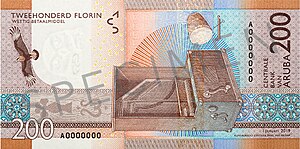
|
Afl. 200 | Brown | Crested caracara | Caha di orgel, drum | |
Current exchange rates
[edit]| Current AWG exchange rates | |
|---|---|
| From Google Finance: | AUD CAD CHF CNY EUR GBP HKD JPY USD JPY USD |
| From Yahoo! Finance: | AUD CAD CHF CNY EUR GBP HKD JPY USD JPY USD |
| From XE.com: | AUD CAD CHF CNY EUR GBP HKD JPY USD JPY USD |
| From OANDA: | AUD CAD CHF CNY EUR GBP HKD JPY USD JPY USD |
See also
[edit]Notes
[edit]- ^ a b "The International Organization for Standardization (ISO) uses the abbreviation 'AWG' as the currency code for Aruba. However, Aruban law uses the abbreviation 'Afl.' for the Aruban florin." Centrale Bank van Aruba, Glossary
- ^ Centrale Bank van Aruba, Annual Statistical Digest 2011
- ^ "Official Currency of Aruba". www.aruba.com.
- ^ Linzmayer, Owen (26 April 2011). "Aruba". The Banknote Book (1st ed.). San Francisco. p. 7.
{{cite book}}: CS1 maint: location missing publisher (link) - ^ Centrale Bank van Aruba (8 October 2015). "Banknotes and Coins".
- ^ Centrale Bank van Aruba (8 October 2015). "Banknotes and Coins - Security Features".
- ^ "Aruba Wins IBNS 2019 Bank Note of Year Award". International Bank Note Society. February 2020. Archived from the original on 2020-07-16. Retrieved 5 January 2021.
External links
[edit]- Krause, Chester L.; Clifford Mishler (1991). Standard Catalog of World Coins: 1801–1991 (18th ed.). Krause Publications. ISBN 0873411501.
- Pick, Albert (1994). Standard Catalog of World Paper Money: General Issues. Colin R. Bruce II and Neil Shafer (editors) (7th ed.). Krause Publications. ISBN 0-87341-207-9.

